Posted by Wendel Swan on 06-19-2007 11:57 AM:
Perhaps a legacy and certainly a great carpet
Dear all,
Some of the pleasures of a rug conference are obvious. We
see exhibitions and old friends, browse the dealers’ fair, hear lectures, enjoy
the host city and spend too much along the way on more wool than we need.
Sometimes we make new friends or gain knowledge or buy something that we
thereafter associate with the conference. Perhaps it affects us in other ways,
but too often the enjoyment is ephemeral.
ICOC-XI in Istanbul was,
according to many observers, the “best ever,” perhaps because of the spectacular
exhibitions, the locale, and the hospitality of the Turkish people.
In
order to permanently memorialize the ICOC conferences, Robert Pinner insisted on
publishing catalogs and papers. That is a tradition of which I am especially
proud.
But ICOC-XI may have left a legacy beyond the all those memories
and the now-expected catalogs and papers, something in which we should all take
pleasure. I refer to the revitalization of interest within Turkey itself of its
heritage and tradition of carpet making and to the state of the museum carpets
that we saw.
ICOC organized a fund for the restoration of the rugs at the
Turk ve Islam Eserleri Muzesi (TIEM), arguably where some of the world’s most
important carpets are held. The fund received donations from both individuals
and rug societies. One extremely generous Turkish donor was moved to make his
contribution when he learned of the American efforts on behalf of the
TIEM.
Those who visited the TIEM saw these spectacular rugs cleaned and
re-mounted.
I can’t say for certain whether the decision to hold ICOC-XI
in Istanbul was a cause or catalyst of the many changes that took place in
Turkey around this conference. I only know that the TIEM carpets were cleaned
and conserved, that the rugs in the old Vakiflar have been moved from their
deplorable conditions, that the law changed so that it is now possible to
legally take old rugs into Turkey, that new Vakiflar museums have been created
and that there seems to be in Turkey a new awareness of and appreciation for its
own extraordinary and long weaving tradition.
Those of us involved in
ICOC are all unpaid volunteers. Not even all of our expenses are covered. If we
had a role in these results, all the work that went into helping to organize the
Istanbul ICOC was worth it.
For those who are not familiar with the
TIEM’s holdings, here is an example of its treasures. At the opening reception,
I spoke with one fellow who, along with another conservator, had spent six full
months working on this monumental carpet:
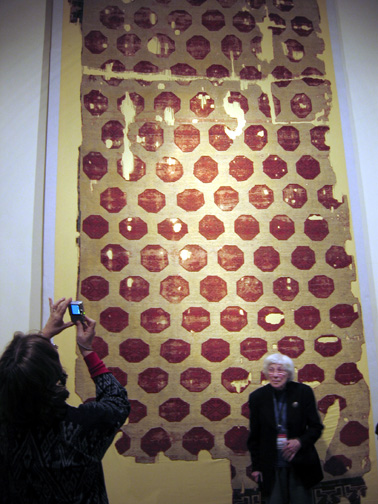
This is a Seljuk carpet of
the 13th or 14th Century, measuring 6 meters in length, almost 20 feet. It was
difficult to get decent pictures of any of the carpets that night. While I have
better images from previous visits, the presence of the two women demonstrates
the scale of the carpet. Before I saw it for the first time, I had paid no
attention to the dimensions in the books and assumed it was much smaller. I can
only say that I was stunned when I saw it in the flesh that first time. It is
truly breath-taking. It is also on the cover of the catalog.
It's hard
for me to imagine that there could ever be another rug conference with such
wonderful offerings. And I believe that we left something good
behind.
Best,
Wendel
Posted by R. John Howe on 06-19-2007 12:37 PM:
Wendel -
Our assessment of rugs that might be truly of note is
interesting.
Consider this piece, which I agree, is very, very impressive
when one is facing it.
How inadequate is our ability to describe it. It
has a quite narrow palette. Its designs are among those seen as easier to weave.
It's overall composition is simple in the extreme. And it has no, repeat, no
borders.
Folks who have not faced it might be excused for asking what all
the excitement is about. Do its merits reside mostly in its estimated
age?
I do agree that the TIEM material alone was almost too rich to take
in in the time we had to look at it. That is likely reason enough to buy the
expensive conference catalog. The TIEM pieces are included in one
volume.
Regards,
R. John Howe
Posted by Marty Grove on 06-19-2007 01:13 PM:
Legally allow material INTO Turkey?
G'day Wendel,
Your sentence surprised me - that there were measures in
place legally to obstruct bringing weavings INTO Turkey; one would think they
may be protective of outgoing stuff, but why on earth would they have originally
at some time, legislate to keep it from coming IN!?
Did they
differentiate between incoming old Turkish rugs, or from the general weaving
world?
From the pictures and discussion on this Salon of ICOC 11, its
fairly obvious that there was an almost unbelievably monumental display of
weavings from across the board. And that your team initiated and were
instrumental in the resurrection and upgraded housekeeping of an entire Museums
collection is incredibly worthy for which you all should take a
bow.
Perhaps more importantly, a very visible and selfless action by
interested Westeners to improve the presentation of a section of Muslim Turkeys
historical and cultural artifacts may help ease perceptions of east and wests
divergence.
Taking out the religeous and political differences, one might
notice that in much else we are very similar. Make friends, not trouble I
say.
Regards,
__________________
Martin R.
Grove
Posted by Wendel Swan on 06-19-2007 02:26 PM:
Hello Marty,
The law prohibiting imports was, I am certain, pure
protectionism on behalf of the carpet industry in Turkey. In recent years, the
concern was for rugs from China and India coming into Turkey. While that may not
seem to make sense when applied to antique carpets, four years before ICOC-XI
the International Committee of ICOC was very concerned about the viability of a
Carpet Fair if dealers from outside Turkey could not bring their merchandise
with them. We couldn’t sanction a full ICOC for Istanbul until that issue was
favorably resolved, which it was. An act was pending before the Turkish
legislature as we were meeting with commerce ministers in Ankara.
I have
suggested that ICOC may have been a catalyst in this process, which I do
believe. But Turkey also wanted to become a member of the EU and reducing trade
barriers toward that end undoubtedly played an important
role.
Nevertheless, I believe that ICOC-XI served as one example of how
to attract visitors and commerce to Turkey.
You point out how similar
“we” are in spite of religious differences. Turkey has been primarily a secular
country, although there are Islamist movements there. But I would cite a HUGE
difference between the United States and Turkey. I can’t believe that any Turk
who came here without English skills could receive the same welcome and help as
I and others experienced in Turkey. They are the most hospitable people you
could ever find.
Wendel
Posted by Jack Williams on 06-19-2007 02:32 PM:
coffee, iceboxes, and coals
Marty...
Some time ago (ok 35 years or so) I went to Columbia for a
summer. They did not want you do bring coffee into the country and I noticed a
small bottle of instant coffee confiscated from a gent ahead of me.
Likewise, I've heard that it is not a good idea to take an icebox to
Alaska or carry coals to New Castle...but I don't have firsthand information on
the last two. Any rules about bringing roos, rabbits, or dingos into
Australia?

Regards,
Jack
Posted by Wendel Swan on 06-19-2007 03:40 PM:
Hi John,
You posted: “It's overall composition is simple in the
extreme. And it has no, repeat, no borders.”
Clearly the field is nearly
minimalist, but there is an epigraphic border that is typically Seljuk. There
are remnants of the border at both the top and the bottom. Witness the top with
some of the medallions:
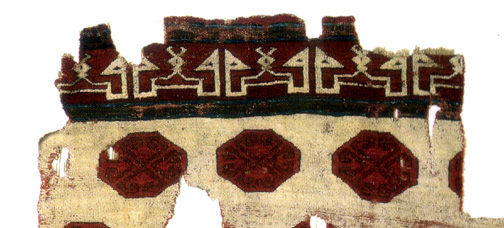
The border is small
in comparison to the field and doesn’t show in my image.
The extant
Seljuk carpets commonly have repeating designs contrasted with these strong
borders. In this case the octagons contain a quadripartite form that is seen
over the millennia. Such forms have been discussed extensively here on Turkotek
where we’ve seen examples in Coptic textiles.
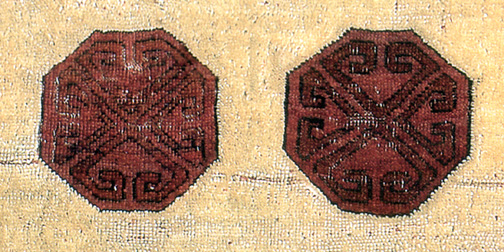
These medallions use
the red-on-red technique used in many Turkmen and Belouch rugs, but I have to
apologize for the color quality here.
John, you ask: “Do its merits
reside mostly in its estimated age?” I think so, but it is visually stunning and
I would refer to it as important rather than necessarily beautiful.
One
cannot appreciate this TIEM rug outside its historical context. As far as I
know, it is the oldest, nearly complete large carpet in existence. Earlier
material from Anatolia and other regions is mostly fragmentary. It had to have
been made for an important person or place; it is an important artifact of an
important era.
It is not a technical tour de force. The medallions are
not uniformly woven. The range of color is indeed limited. While I realize that
bigger is not necessarily better, its monumental size is impressive.
Within the TIEM, it is located in the rear-most gallery. After seeing
one great rug after another, one might expect to become sated. But when I
reached it for the first time (a few years ago), I felt about the way I did when
I encountered Hammurabi’s Code at the Louvre earlier this year: I knew that I
was in the presence of something very important. It was a thrilling
sight.
Wendel
Posted by Patrick Weiler on 06-19-2007 07:24 PM:
Proto Turkmen
This very large rug that Wendel has pictured was one of the more striking
pieces at the TIEM. It is also partially pictured in the Gantzhorn book The
Christian Oriental Carpet, with the note "The inner panel consists of Kotshak
crosses set in octagons, which are laid out like tiles to form a composition
familiar from early Christian mosaics in Antioch."
and:
"If carpets were
being done by Christian weavers for the Seljuk or Mongolian occupying power,
then some of them may be found in these groups (with pseudo-Kufic borders),
whereas the so called Hoof-Mark pattern (in this rug) represents yet another
example of the continuation of the Armenian-Syrian tradition of
designs."
This rug has also been considered as a proto-Turkmen design,
familiar to the more recent Turkmen main carpets, but with a white field instead
of the common red field.
And Wendel is right. Some of the TIEM rugs are so
large as to resist photographing the entire thing. A couple of Kurdish garden
carpets were so long that they trailed onto the floor, even though the ceilings
in the TIEM were extraordinarily high. And with all the people in the museum at
the same time, it was difficult to take a picture without someone in the way.
The Kilim exhibit was even more crowded, due to being in a smaller
venue.
John sent me some photos that he took at the TIEM and Vakiflar
museums, some of which are shown below:
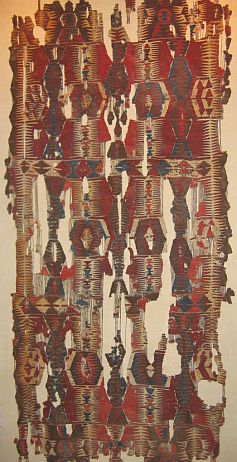
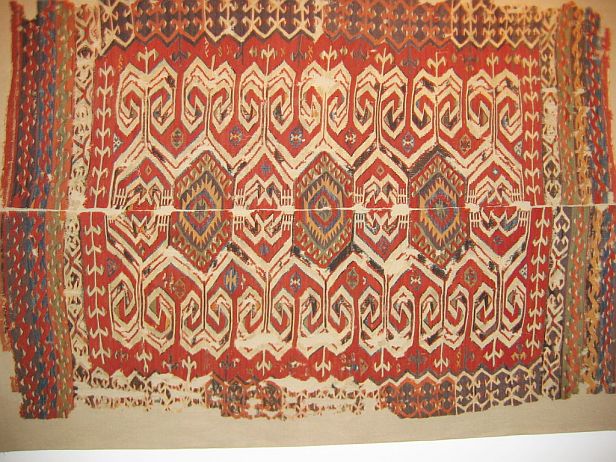
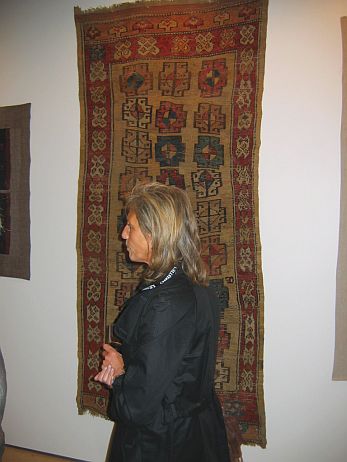
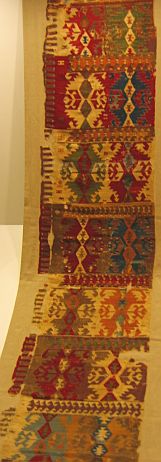
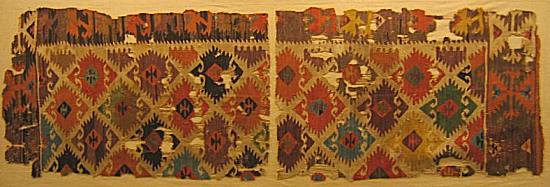
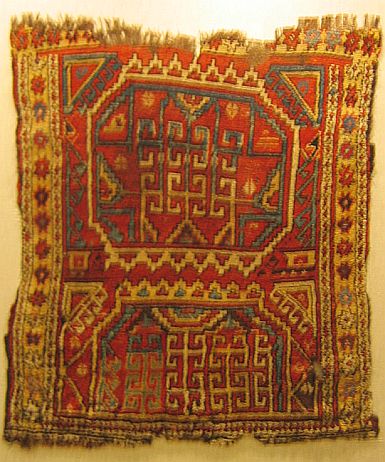
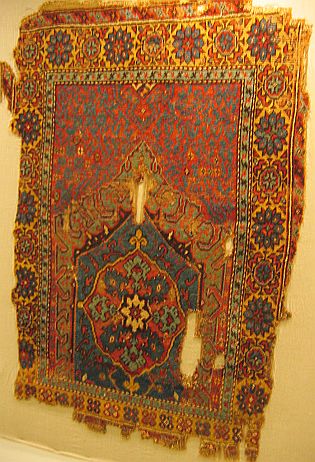
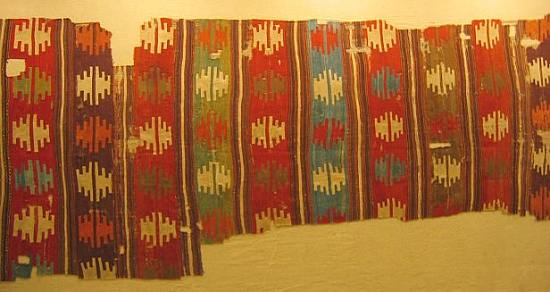
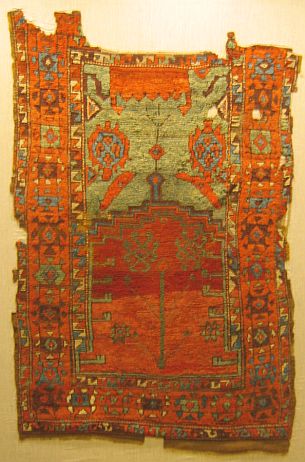
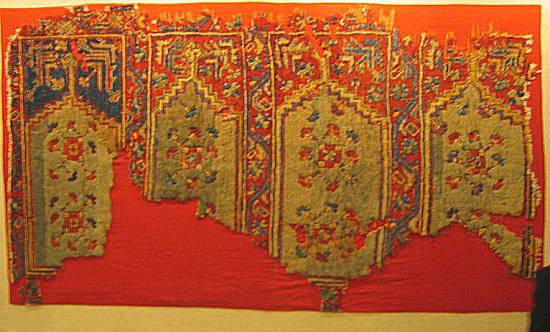
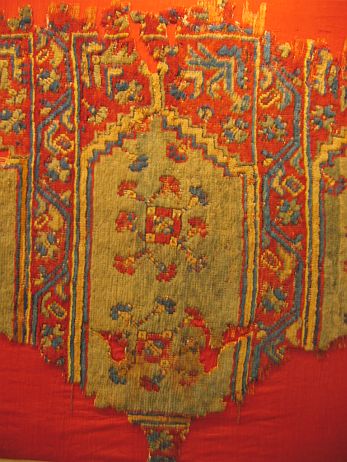
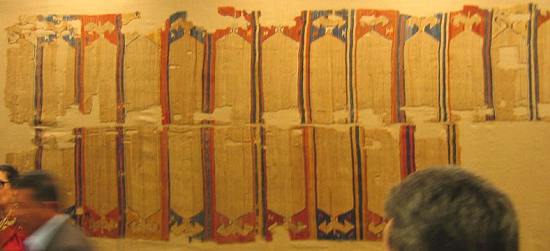
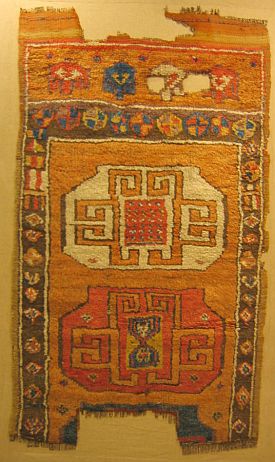
And here is another
batch:
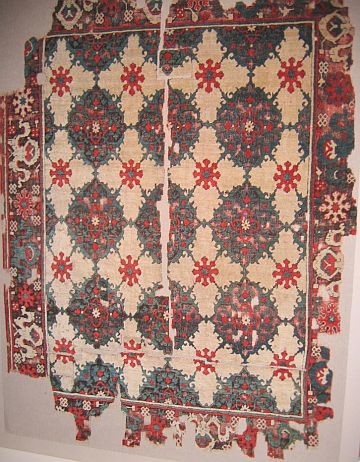
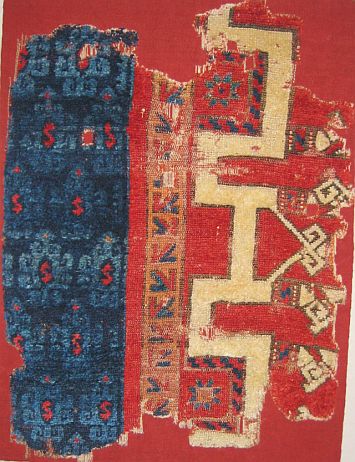
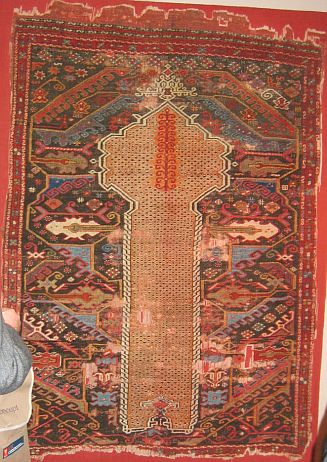
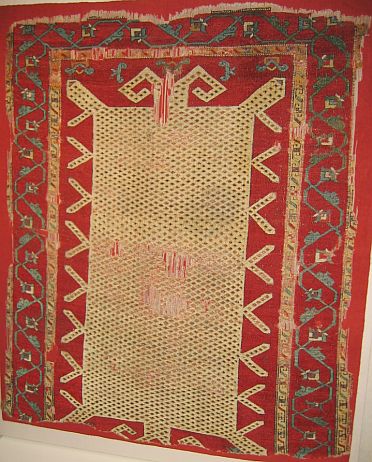

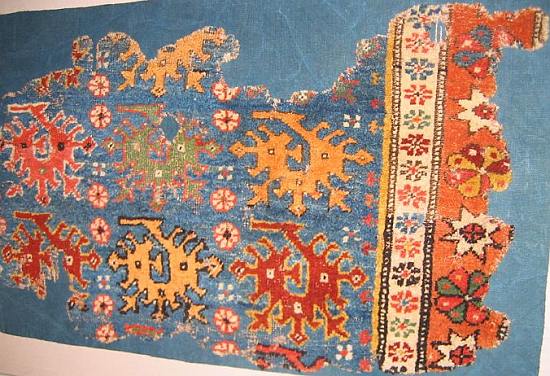
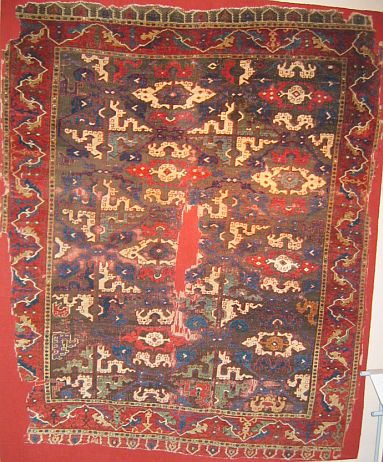
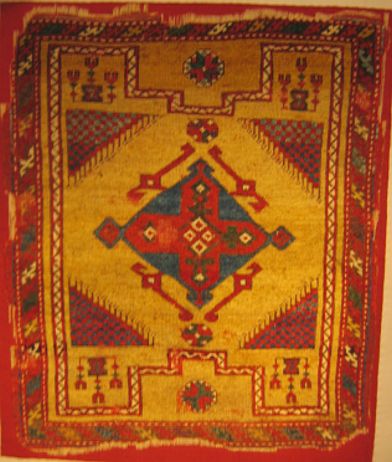
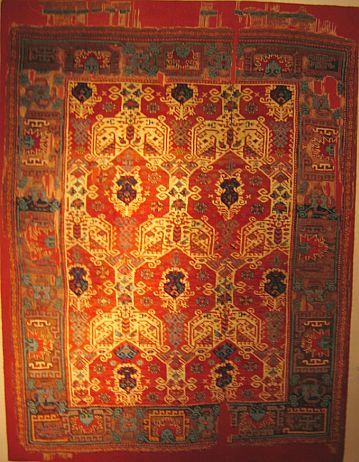
This is a lot of photos, and
it is probably not the last of the pictures for this salon, but it gives you a
sense of the quantity and quality of pieces housed in Istanbul. A tremendous
amount of work has been done, and a lot more is forthcoming. It is quite
gratifying that the sorry conditions that so many of these carpets have been
subjected to has finally been improved.
Patrick Weiler
Posted by R. John Howe on 06-19-2007 09:09 PM:
Not Sure Where Some Were Taken
Pat -
Not to deflect from enjoyment of this material, but I have to
admit that I'm not entirely sure, at the moment, of where each of the pieces
here was, in fact, taken.
I know that this piece

was part of Paksoy exhibition of
kilims and carpets at the Rezan Has Museum on one of the receptions on April 18.
The Vakiflar and the TIEM material was not seen that night.
When I sent
the images to you I thought that they were from the Vakiflar exhibition, but I
think there is TIEM material in them and some from the Rezan Has as
well.
So we need to cautious about saying where they were taken. The date
on my digital camera seems to have put some things that happened one day on the
next.
A systematic comparison with the images Jeff Krauss took and his
labeling might help sort things out, but I haven't been able to do
that.
Sorry for the confusion.
R. John Howe
Posted by James Blanchard on 06-19-2007 11:01 PM:
Hi all,
I think I would fall into the camp of referring to the large
Seljuk carpet as being "important" and "impressive", but I am not sure how I
would react to such a carpet aesthetically if I did not know how old and
important it is.
I'm sure much has been written about it that I haven't
read, but on first impression it strikes me as an oddity. It is such a huge
carpet that it must have been made on a very large loom in a settled place for a
very large space. But the design and execution seems very crude. Perhaps it was
made with a deliberate austerity, but if you look at first octagon in the second
picture of Wendel's last post you can see that the weaver was unable to
consistently render even the basic and simple design. It strikes me as the
creation of a primitive weaving culture, or an inexperienced weaver, or both.
But why would such an inexpert weaver have such a big loom and use so much wool
to create such a large and simple carpet? 
James.
Posted by Steve Price on 06-20-2007 06:17 AM:
Hi James
When seen in person (at least, by me), the sheer scale of the
carpet is an important part of the aesthetic. I think it would look much less
impressive as a floor covering than it does on the wall.
It's unlikely
that a carpet that size was woven by a single weaver, which may account for the
variability in execution. It must have been done as a commissioned piece by
somebody in a high station, and to whatever standard was the norm at the time.
Remember, this was woven around AD1200.
Regards
Steve Price
Posted by James Blanchard on 06-20-2007 07:04 AM:
Hi Steve,
You said:
quote:
and to whatever standard was the norm at the time. Remember, this was woven
around AD1200.
I suppose you would need to amend this to "whatever standard
was the norm at the time AND place". Given the technical quality of the Pazyryk
rug, and others that followed not too long after this Seljuk carpet, a much
higher technical standard of weaving was occurring in some places before, and
probably during that time.
I am curious about whether you and others
think that the apparently impressive aesthetic was the result of a studied and
deliberate design, or something a bit more random. I suppose that some of the
variability could come from multiple weavers, but it looks to me like even if
there were multiple weavers none of them were highly skilled or consistent. Was
the high level of variation in the size and placement of the octagons
deliberate, or just not very precise weaving? If deliberate, what are the other
artistic traditions around that time and place that parallel this sort of
aesthetic?
To me this is a very mysterious carpet. I'll see if I can read
more about it, but would certainly be interested if other Turkotekkers could
enlighten me as well.
James.
Posted by Steve Price on 06-20-2007 08:10 AM:
Hi James,
Of course, I should have said time and place, and added,
circumstances.
This carpet was almost surely woven to cover a floor. If
so, neither the weavers, the designer nor the guy who commissioned it would have
considered what it would look like when hanging on a tall wall where it could be
seen all at once. For that reason, I suspect that the dramatic aesthetic effect
that it has in the museum is more happenstance than planning at the time it was
woven (happenstance or not, it really is dramatic). Irregularities would
probably have been of little concern, for the same
reason.
Regards
Steve Price
Posted by Marty Grove on 06-20-2007 08:22 AM:
Thanks for the explanation Wendel, makes more sense now.
In
similarities, was thinking more of people overall having a desire for
friendship, comfort and plenty and perhaps sharing the love of rugs.
As
for politeness, perhaps thats a residue of Islam and the proscribed hospitality
for strangers now translated simply into being generally polite to those one
does not know?
Hey Jack, please, I can understand the coffee into
Columbia situation - there are many coffees which one would hope not be allowed
into Australia - awful stuff! As to whether we would allow more roos, bunnys and
dingoes into Oz, no thanks, we have enough of them already; and there are a few
'dingoes' Ive had the misfortune to meet whom it would be no loss to export!
Regards,
Marty.
Posted by R. John Howe on 06-20-2007 08:24 AM:
James -
Wendel has acknowledged most of your points.
He admits
that age is likely a major factor in our evaluation of this rug since it seems
to be the least fragmented Turkish rug we have of this size from this
period.
He also acknowledges its technical deficiencies.
There,
are, by the way, lots of variations in older rugs that would seem surely to have
been woven from a cartoon. Jon Thompson did a close study of the Ardebil carpet
once in this regard and demonstrated that there are lots of variations all over
it.
Thompson thinks that one can often study a rug and tell on what basis
it was woven. For example, the complexity of the Ardebil design strongly
suggests that it was made following a cartoon. But the variations Thompson found
suggest to him that the design was "called out" rather than followed knot for
knot on a paper cartoon. Or that the weavers could see what was required by the
cartoon but were free to follow in close approximation.
I don't know
what he would say about the variations in this piece (especially since it is
such a simple design to weave) but the presence of irregularities is not itself
always evidence that a cartoon was not made or employed.
I do think the
size suggests a client and one with a pretty large space in which the rug was to
be used. And I missed the fact that it had a dramatic border. With that, it
would have been a pretty impressive piece despite the simplicity of the field
design.
But, like you, I do think this is a good example for pressing the
bases of some of the positive evaluations we sometimes make of particular
pieces. It is not so much a debate about whether a given evaluation is deserved
as it is a matter of making visible the different bases being used. Novices
could get understandably confused reading some
evaluations.
Regards,
R. John Howe
Posted by James Blanchard on 06-20-2007 08:49 AM:
Hi Steve and John,
I think it is the apparent simplicity and, could I
say, crudeness, in such a large carpet that surprises me. Whatever the
circumstances of design and execution, it seems that not one of the weavers
could consistently execute the basic octagonal design. If deliberate, then
perhaps I need to look at it in an entirely different light. If not, then I am
still curious about the fact that there was the manufacture of such large
carpets with such unskilled weavers. It is almost as if they started making very
large carpets for very large rooms before they had gotten some of the basics
down pat.
John, might I suggest that whatever the irregularities in
design of the Ardebil carpet, it is in an entirely different category than this
rug. The Ardebil is obviously much more sophisticated, or at least complex, in
terms of design and execution.
If the Seljuk was made based on a cartoon,
imagine what the cartoon looked like.
James.
Posted by Richard Larkin on 06-20-2007 07:21 PM:
Hey folks,
As far as the big old Seljuk rug is concerned, I think it
has a spectacular look. Much more interesting to me, however, it the fantastic
variety and lack of triteness among these wonderful pieces. I am always keen to
know what was being woven in the dim past, and I'm always gratified when it
turns out to be on the wild side.
__________________
Rich
Larkin



























